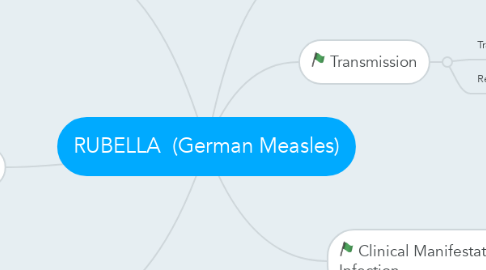RUBELLA (German Measles)
by Qofarudin Wahab


1. Clinical
1.1. Low grade fever only at D1
1.2. malaise, lethargy, headache, coryza, (prodrome 1- 5 days before rash)
1.3. Maculopapular rash
1.3.1. appear first on the face and neck and quickly spread to the trunk and upper limbs and then lower limbs.
1.3.2. last 3 to 5 days (3-day measles)
1.4. Lymphadenopathy
1.5. Forchheimer spots - small mucosal petechial on the soft palate
2. Investigations
2.1. Enzyme Immunoassay
2.1.1. +ve IgM for new infection
2.2. ELISA/Immunofluorescent test
2.2.1. +ve IgG
2.3. Viral isolation from nasopharyngeal secretion
2.4. The persistence of IgG antibody beyond 6 months or the demonstration of IgM antibody is diagnostic for congenital rubella infection .
3. Management
3.1. Rubella vaccination
3.2. Supportive management of congenital rubella syndrome and its complication
4. Causative Organism
4.1. Togavirus
4.1.1. single stranded RNA virus
4.1.2. Incubation period 14-21 days
4.1.3. Via direct contact or droplet
5. Transmission
5.1. Transplancental
5.2. Respiratory secretion
6. Clinical Manifestation in Congenital Infection
6.1. Maternal infection before 8 weeks of gestation
6.1.1. Deafness
6.1.2. Congenital Heart Disease (PDA/VSD)
6.1.3. Cataract
6.2. Maternal infection at 13-16 weeks of gestation
6.2.1. Impaired hearing
6.3. Maternal infection after 18 weeks of gestation
6.3.1. Minimal risk to fetus
6.4. Others
6.4.1. Growth restriction, microcephaly, mental retardation, bone disease (long bone radiolucencies), hepatosplenomegaly, blueberry muffin appearance, anemia, thrombocytopenia
